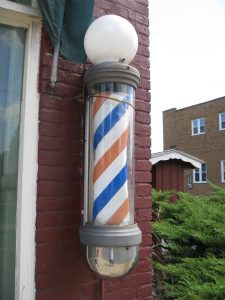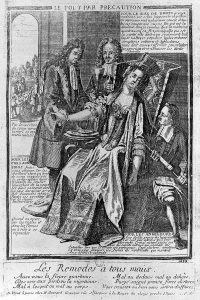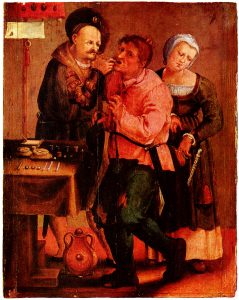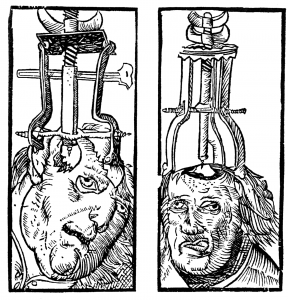Chances are, if you are able to read this, you’re going to be familiar with the Barber’s pole. For those misty on the subject here’s a friendly reminder:
Now you’re probably thinking, why is this guy so condescendingly describing a Barber’s pole, and why is he talking about it? We here at Dark Stag thought you at home might be interested to know the pole has a pretty bloody history…
As you may have guessed, barbering is an ancient profession, the earliest example of a barber razor is over 20,000 years old (unbranded blade though)! As celebrated in the past as they are now, but the Barber’s pole story is far more recent… only around 1000 years old. That’s right, that twirling doodad that you thought was ‘pretty’ as a child (let’s be real, as adults too) has 1000 years of experience under its belt.
It begins, as these quaint objects always do, in the medieval times, where a barber’s profession was also that of a surgeon. Yeah. We meant that kind of bloody history. In addition to haircutting, hairdressing/styling, and shaving, barbers performed surgery, bloodletting and leeching, fire cupping, enemas, and the most relaxing of dentistry, tooth extraction; earning them the name “barber surgeons”. Not sure how I feel about Dave giving me a slick fade and then whipping my kidney out, but I guess that’s trust issues on my part.
Just want to take a moment to say, that whilst I can certainly recommend the Dark Stag range of scissors and razors for all of your barbering needs, please, please, please refrain from any keyhole surgery with our tools. Strictly use our moustache scissors for that, they have a much finer point and can really get deep in there with minimal damage. Really makes you appreciate that a cut throat razor has a different meaning…
The theory at this point is the barber’s pole represented 3 different parts of the trade, a wash basin at the top representing the bowl that held the leeches, the bottom bowl that caught the blood, and the pole itself representing the staff that patients would grip to encourage blood flow and distract from the pain. With the standards of the time I’m not sure if the blood flow is for the surgery or haircuts going spectacularly wrong, barbers scissors can do a lot of damage in the right hands.
Massive changes in medieval life usually originated in France, and the barbering world is no exception. In 1163 the Council of Tours the clergy were banned from practicing surgery (apparently anyone was up for a go). From then on, physicians were split into 2 groups, surgeons and barbers, sorry Dave.
Following all this confusion about naming, job role, and who was allowed to medicinally stab someone, the role of the barbers was defined by the College de Saint-Côme et Saint-Damien, established by Jean Pitard in Paris around 1210, as “academic surgeons of the long robe and barber surgeons of the short robe”. Glad that clears things up.
After the formation of the United Barber Surgeon’s Company in England (1540), which would one day go on to become the Worshipful Company of Barbers, a statute required barbers to use a blue and white pole, and surgeons to use a red pole. The French, of course, had to be different and stuck a bowl on the bottom of the pole for surgeons, though not sure if a Dark Stag shaving bowl would be all that effective at catching the gallons of blood you would lose.
Since then the two professions have, thankfully, continued to diverge, but the barber’s pole has stayed the same, a powerful image that is almost globally recognised. Even if it is popularly thought to be meaning red for blood and white for bandages, although I would put the bandages on the bloody area personally, but what do I know?
But what would a good article be without mentioning controversy? That’s what you all came here for, the juicy goss. Well a little birdy told me that the pole is particularly controversial in the good ol’ US of A, such as in Michigan 2012, when legislation emerged that only barbers, not hairdressers or cosmetologists, can use the barber’s pole. Barbers and cosmetologists have engaged in several tedious legal battles claiming the right to use the barber pole. Barbers claim that they are the only ones able to use the barber pole because of ’tradition’, whereas cosmetologists think that they should also be able to as they can cut men’s hair. Similarly, there are several states that do not allow hairdressers or cosmetologists to use razors by law! It really doesn’t get juicier than that.
Oh, other than how the poles are used in prostitution in South Korea. Brothels use the poles to disguise their businesses, usually with two spinning opposite ways. But you guys don’t want to hear about that…
So I guess you could say we should really be thankful that things have changed, a wet shave could have entirely different meanings with a slip of the hand, and half the time back then you wouldn’t know if it was intentional to ‘let the blood out’ or just a drunken accident (beer and wine were the only reliable sources of clean drinking fluids).
Until next time, and any barbers reading this keep your fingers outside of your customers bodies, unless they ask.
Dark Stag Team
All images displayed in this article are used from wikimedia commons.










